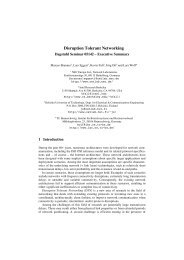A New Design Methodology for Network Architectures - Lars Eggert
A New Design Methodology for Network Architectures - Lars Eggert
A New Design Methodology for Network Architectures - Lars Eggert
Create successful ePaper yourself
Turn your PDF publications into a flip-book with our unique Google optimized e-Paper software.
latter represents a lower percentage of investment or<br />
maintenance cost than the <strong>for</strong>mer).<br />
• Does an invariant have security or privacy implications?<br />
Invariants concerning user characteristics or behavior may<br />
be more limiting than others. Examples include the SIM<br />
card on which cellular networks depend <strong>for</strong> user<br />
authentication. In the Internet, IPv4 addresses are still<br />
frequently used by various security mechanisms, such as in<br />
IPsec [13]. Additional problems arise where these invariants<br />
become associated with regulatory constraints (location<br />
privacy, traffic interception, competition policy through<br />
identifier portability).<br />
• Does an invariant have internal flexibility? An invariant,<br />
especially one used as some sort of identifier, may have the<br />
disadvantage of being ubiquitous or deeply embedded in<br />
implementations. However, if it has an evolution path of its<br />
own (typically some non-trivial syntax) this can mitigate<br />
one or both of these problems. An example from the Internet<br />
is the evolution from classful to classless IP addressing,<br />
where the IP address <strong>for</strong>mat could be re-interpreted with a<br />
more sophisticated syntax in a way that was transparent to<br />
end systems. Telecommunications identifier schemes have<br />
often exploited the possibility to do relatively complex<br />
processing within the control plane to use variable as<br />
opposed to fixed length identifiers.<br />
It is important to note that the goal of evaluating the invariants of<br />
various architectural designs is to determine which design is likely<br />
to gracefully adapt to future change – in a sense, how far in the<br />
future the design’s expiration date lays. This evaluation is not<br />
concerned with quality, functionality or usefulness. The designers<br />
will of course also need to consider all these aspects during the<br />
design process. Evaluating competing designs solely based on<br />
invariants may result in an architecture with minimal invariants<br />
but no useful functionality.<br />
The main Internet invariant, the IPv4 address, is definitely<br />
ubiquitous. It affects all nodes, and has security implications.<br />
There<strong>for</strong>e, it would rate poorly according to the above criteria. On<br />
the other hand, one might argue that one ubiquitous invariant is<br />
better than many “less worse” ones.<br />
A common characteristic of the invariants in the Internet<br />
architecture is that the problematic ones are confined to the<br />
network and transport layers, i.e., to the “waist” of the hourglass<br />
in the protocol stack. In this respect, they get good marks on the<br />
second criterion. This classification supports the expectation of<br />
flexibility that the architecture has shown with respect to new<br />
applications and link technologies. Confining invariants to a<br />
limited part of the design, whether physical equipment, logical<br />
layers or something else, is important to not unnecessarily limit<br />
future change. However, note that confining an invariant to the<br />
network layer is still an imperfect state of affairs, given the way in<br />
which all nodes of that layer participate in end-to-end data<br />
transfer; hence the interest in localization architectures and<br />
localized addressing schemes in recent years [3].<br />
Are all invariants bad? No, even though invariants prevent<br />
changes to specific parts of the system, their identification is<br />
necessary to enable changes in the other parts. With clearly<br />
spelled out invariants, an engineer can redesign the parts that are<br />
not constrained, knowing that the architecture will not fall apart.<br />
With this argument, invariants enable evolution in that they, when<br />
well-defined, facilitate change. One conclusion that can be drawn<br />
from this argument is that an architecture is better with few, strong<br />
and well-defined invariants, than many loosely defined ones.<br />
4. INVARIANTS-AWARE<br />
ARCHITECTURE DESIGN<br />
One of the main objectives behind the proposed invariant<br />
methodology is to facilitate designers to assess an emerging<br />
(network) architecture in order to identify potential problems or<br />
inconsistencies with the actual architectural objectives as early in<br />
the design phase as possible.<br />
For this, we propose that designers follow an iterative design<br />
process that requires the architects to revise an evolving<br />
architecture several times. This also means that the architecture<br />
needs to be analyzed very early in the process in order to reduce<br />
the number of redundant artifacts. At each round of the design<br />
cycle, the architects use the following process:<br />
• Identify the architectural invariants. Review the draft<br />
architecture and identify its invariants. Because of various<br />
possible viewpoints about an architecture [18], identifying<br />
its invariants might involve several iterations. Nevertheless,<br />
an evaluation from any viewpoint is expected to yield some<br />
set of invariants. A <strong>for</strong>mal way of identifying a complete set<br />
of invariants, however, is not likely to exist. Typically,<br />
implicit invariants may be hardest to identify. Challenging<br />
an architecture with usage scenarios that were not<br />
considered during the initial design may be an effective tool<br />
to isolate them.<br />
• Evaluate the invariants against the set of characteristics<br />
given in Section 3 and determine if the invariants only apply<br />
where expected. For example, to support terminal mobility<br />
host identity should be independent from terminal location.<br />
Verify whether all invariants con<strong>for</strong>m to the design<br />
requirements. For example, if a design requirement is high<br />
scalability, verify that no invariant design decision limits<br />
this characteristic.<br />
• Revise architecture based on invariant evaluation. If<br />
invariants conflict, modify the architecture early to reduce<br />
the potential <strong>for</strong> inconsistencies during the implementation<br />
or deployment phases. This iterative design process helps<br />
reduce undesired side effects.<br />
Note that evaluation based on invariants also aids in finding<br />
consensus on the quality of a given architecture. However,<br />
evaluation highly depends on the applied characteristics of an<br />
invariant. There is no proven set of characteristics, or a <strong>for</strong>mal<br />
way <strong>for</strong> rating a given invariant against them. Additionally, the<br />
main target of evaluation is the degree to which the architecture<br />
can evolve over time. Functional requirements on the architecture<br />
are not taken into account in that design methodology, but they<br />
are rather obviously given by potential users/stakeholders of the<br />
architecture.<br />
5. CONCLUSION<br />
This paper proposed a methodology <strong>for</strong> designing new network<br />
architectures, motivated by the view that evolution and<br />
interworking flexibility are constrained not so much by the





